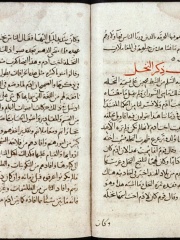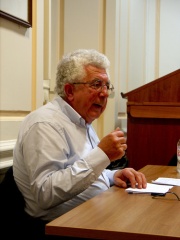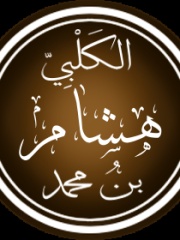





The Most Famous
HISTORIANS from Iraq
This page contains a list of the greatest Iraqi Historians. The pantheon dataset contains 561 Historians, 7 of which were born in Iraq. This makes Iraq the birth place of the 13th most number of Historians behind Austria, and Israel.
Top 7
The following people are considered by Pantheon to be the most legendary Iraqi Historians of all time. This list of famous Iraqi Historians is sorted by HPI (Historical Popularity Index), a metric that aggregates information on a biography's online popularity.

1. Al-Baladhuri (806 - 892)
With an HPI of 72.19, Al-Baladhuri is the most famous Iraqi Historian. His biography has been translated into 38 different languages on wikipedia.
ʾAḥmad ibn Yaḥyā ibn Jābir al-Balādhurī (Arabic: أحمد بن يحيى بن جابر البلاذري) was a 9th-century West Asian historian. One of the eminent Middle Eastern historians of his age, he spent most of his life in Baghdad and enjoyed great influence at the court of the caliph al-Mutawakkil. He travelled in Syria and Iraq, compiling information for his major works. His full name was Ahmad Bin Yahya Bin Jabir Al-Baladhuri (Arabic: أحمد بن يحيى بن جابر البلاذري), Balazry Ahmad Bin Yahya Bin Jabir Abul Hasan or Abi al-Hassan Baladhuri.

2. Al-Khatib al-Baghdadi (1002 - 1071)
With an HPI of 61.96, Al-Khatib al-Baghdadi is the 2nd most famous Iraqi Historian. His biography has been translated into 20 different languages.
Abū Bakr Aḥmad ibn ʿAlī ibn Thābit ibn Aḥmad ibn Māhdī al-Shāfiʿī, commonly known as al-Khaṭīb al-Baghdādī (Arabic: الخطيب البغدادي) or "the lecturer from Baghdad" (10 May 1002 – 5 September 1071; 392 AH-463 AH), was an Iraqi Sunni Muslim scholar known for being one of the foremost hadith scholars and historians of his time. He is widely considered an important authority in hadith, fiqh and history.

3. Ibn Wahshiyya (900 - 930)
With an HPI of 61.75, Ibn Wahshiyya is the 3rd most famous Iraqi Historian. His biography has been translated into 22 different languages.
Ibn Waḥshiyya (Arabic: ابن وحشية), died c. 930, was a Nabataean (Aramaic-speaking, rural Iraqi) agriculturalist, toxicologist, and alchemist born in Qussīn, near Kufa in Iraq. He is the author of the Nabataean Agriculture (Kitāb al-Filāḥa al-Nabaṭiyya), an influential Arabic work on agriculture, astrology, and magic. Already by the end of the tenth century, various works were being falsely attributed to him. One of these spurious writings, the Kitāb Shawq al-mustahām fī maʿrifat rumūz al-aqlām ("The Book of the Desire of the Maddened Lover for the Knowledge of Secret Scripts", perhaps 1022–3 CE), is notable as an early proposal that some Egyptian hieroglyphs could be read phonetically, rather than only logographically.

4. Baha ad-Din ibn Shaddad (1145 - 1234)
With an HPI of 61.28, Baha ad-Din ibn Shaddad is the 4th most famous Iraqi Historian. His biography has been translated into 18 different languages.
Bahāʾ al-Dīn Abū al-Maḥāsin Yūsuf ibn Rāfiʿ ibn Tamīm (Arabic: بهاء الدين ابن شداد; the honorific title "Bahā' ad-Dīn" means "splendor of the faith"; sometimes known as Bohadin or Boha-Eddyn) (6 March 1145 – 8 November 1234) was a 12th-century Arabic jurist, scholar and historian notable for writing a biography of Saladin whom he knew well.

5. Hisham ibn al-Kalbi (737 - 819)
With an HPI of 60.13, Hisham ibn al-Kalbi is the 5th most famous Iraqi Historian. His biography has been translated into 21 different languages.
Abu al-Mundhir Hisham ibn Muhammad ibn al-Sa'ib ibn Bishr al-Kalbi (أبو المنذر هشام بن محمد بن السائب بن بشر بن عمرو بن الحارث بن عبد الحارث الكلبي; 737–819 CE / 204 AH), more commonly known as Hishām ibn al-Kalbī (Arabic: هشام بن الكلبي) and as Ibn al-Kalbi (ابن الكلبي), was an early 8th-century Arab Muslim historian. Born in Kufa, he spent much of his life in Baghdad. Like his father, he collected information about the genealogies and history of the ancient Arabs. His genealogies are well-cited among Arabs, but Sunni scholars considered his hadith to be unreliable since he was Shia. Much of his work was preserved by al-Tabari. Ibn al-Kalbi's most famous work is the Book of Idols (Kitab al-Asnam), which aims to document the veneration of idols and pagan sanctuaries in different regions and among different tribes in pre-Islamic Arabia. In this work, Hisham posited a genealogical link between Ishmael and the Islamic prophet Muhammad, and put forth the idea that all Arabs were descended from Ishmael. He relied heavily on the ancient oral traditions of the Arabs, but also quoted writers who had access to Biblical and Palmyrene sources. Hisham is also famous for preserving Abu Mikhnaf's work Maqtal al-Husayn ("The Murder place of al-Husayn") which detailed the events of the Battle of Karbala in 680 based on eyewitness accounts, and was in turn preserved by al-Tabari. According to the Fihrist of Ibn al-Nadim, he wrote 140 works. His account of the genealogies of the Arabs is continually quoted in the Kitab al-Aghani. He also wrote the Strain of Horses (Ansab al-Khayl), which tries to document the history of the Arabian horse from 3000 BC to his own time.

6. Khalifah ibn Khayyat (777 - 854)
With an HPI of 57.26, Khalifah ibn Khayyat is the 6th most famous Iraqi Historian. His biography has been translated into 17 different languages.
Khalīfa bin Khayyāṭ bin Khalifa bin Khayyāṭ al-ʿUṣfūrī al-Shaybānī al-Dhuhlī al-Tamīmī al-Laythī Abū ʿAmr Shabāb (Arabic: خليفة بن خياط بن خليفة بن خياط العصفوري الشيباني الذهلي التميمي الليثي أبو عمرو شباب; 777–855) comonly known by his nickname Shabab or simply Khalifa Ibn Khayyat was a Basran Arab Islamic scholar, traditionist, historian, chronicler and genealogist. A member of a scholarly Basran family of hadith transmitters, he became known primarily for his contributions to history and biographical literature. His Taʾrīkh is the earliest extant Islamic chronicle, covering events from the Prophet’s life to 232/847, while his Ṭabaqāt is one of the earliest surviving Islamic biographical dictionaries, cataloguing more than three thousand transmitters of hadith.

7. Avi Shlaim (b. 1945)
With an HPI of 55.33, Avi Shlaim is the 7th most famous Iraqi Historian. His biography has been translated into 18 different languages.
Avi Shlaim (Hebrew: אבי שליים, Arabic: أفي شلايم; born 31 October 1945) is an Israeli and British historian of Iraqi Jewish descent. He is one of Israel's "New Historians", a group of Israeli scholars who put forward critical interpretations of the history of Zionism and Israel.
People
Pantheon has 7 people classified as Iraqi historians born between 737 and 1945. Of these 7, 1 (14.29%) of them are still alive today. The most famous living Iraqi historians include Avi Shlaim. The most famous deceased Iraqi historians include Al-Baladhuri, Al-Khatib al-Baghdadi, and Ibn Wahshiyya.
Living Iraqi Historians
Go to all RankingsDeceased Iraqi Historians
Go to all RankingsAl-Baladhuri
806 - 892
HPI: 72.19
Al-Khatib al-Baghdadi
1002 - 1071
HPI: 61.96
Ibn Wahshiyya
900 - 930
HPI: 61.75
Baha ad-Din ibn Shaddad
1145 - 1234
HPI: 61.28
Hisham ibn al-Kalbi
737 - 819
HPI: 60.13
Khalifah ibn Khayyat
777 - 854
HPI: 57.26

